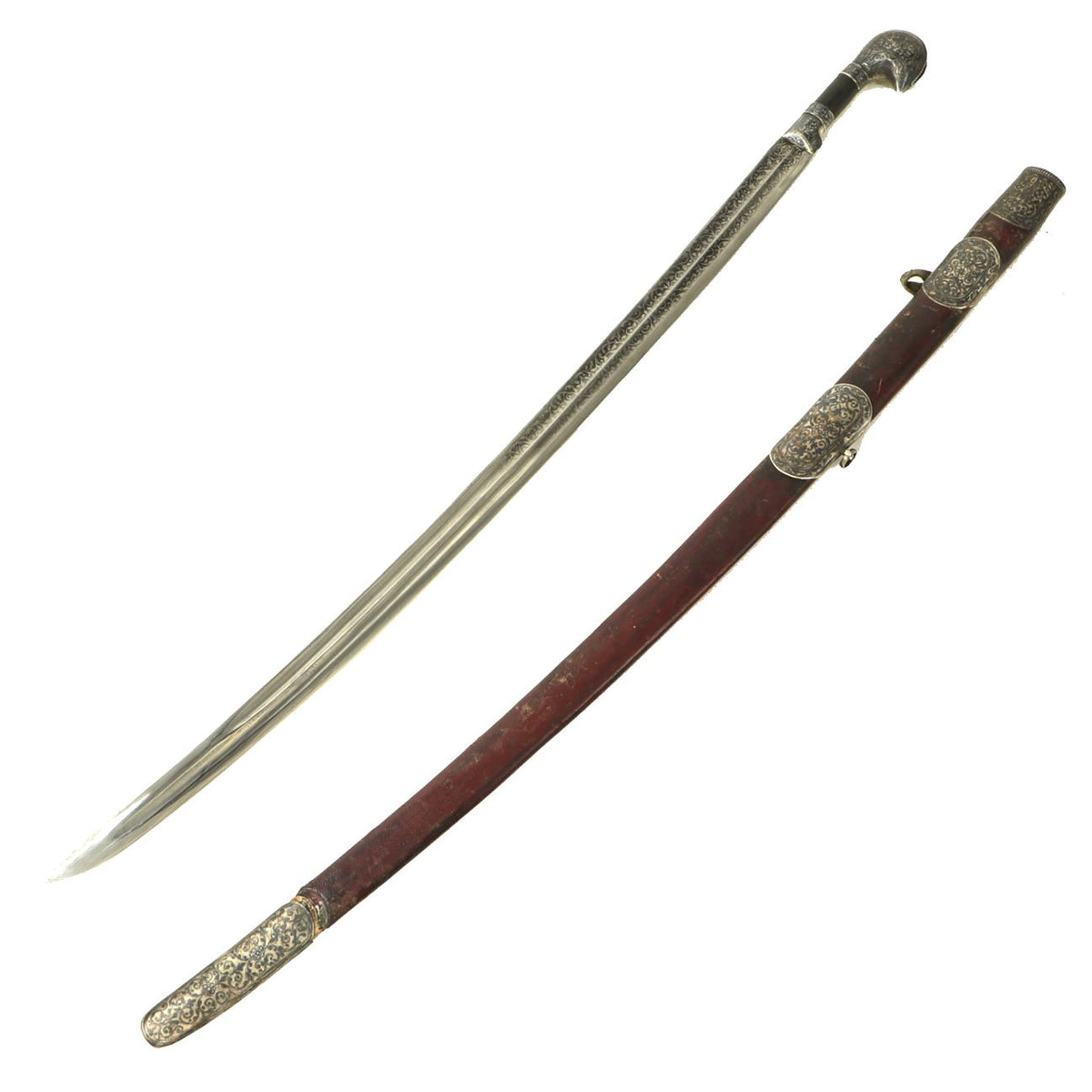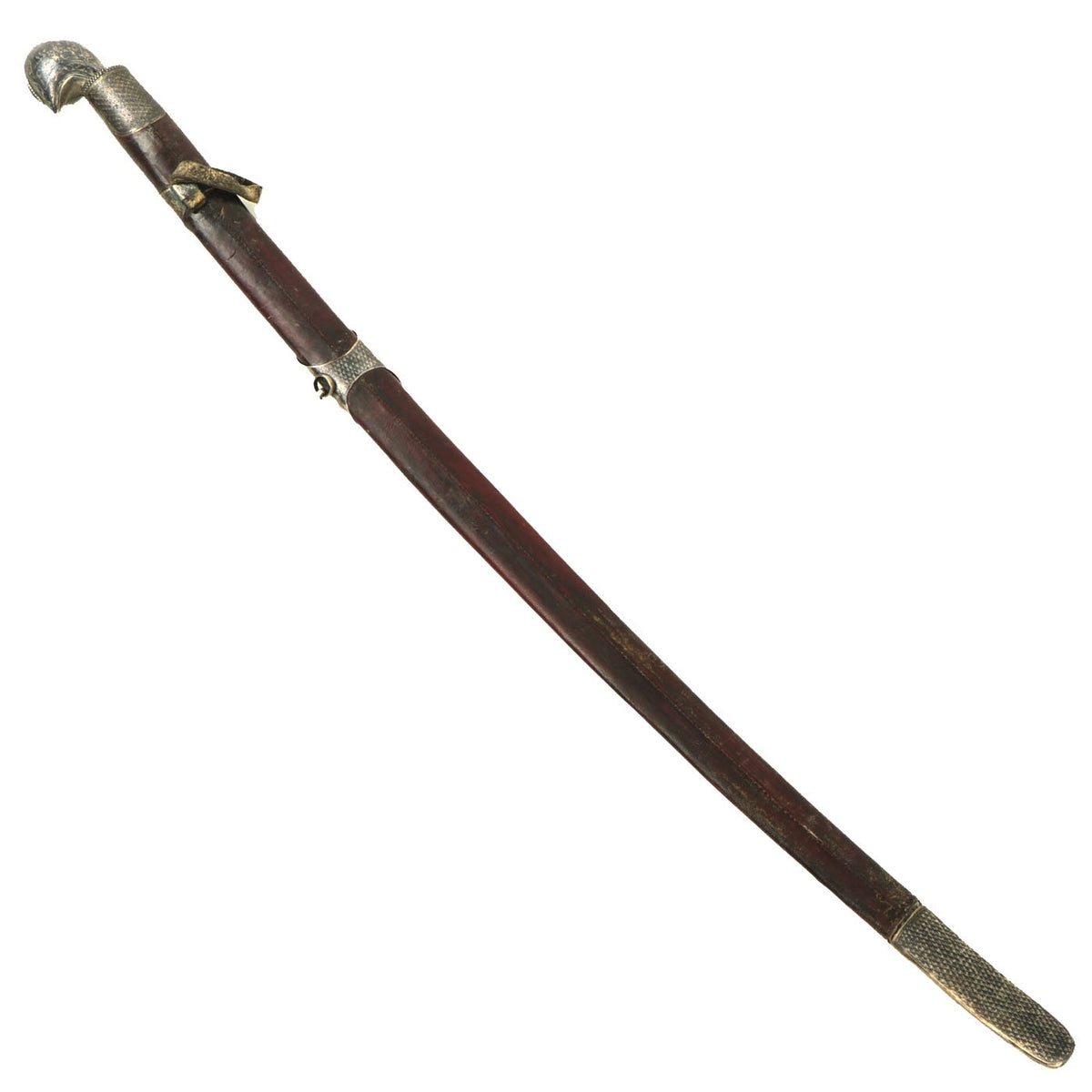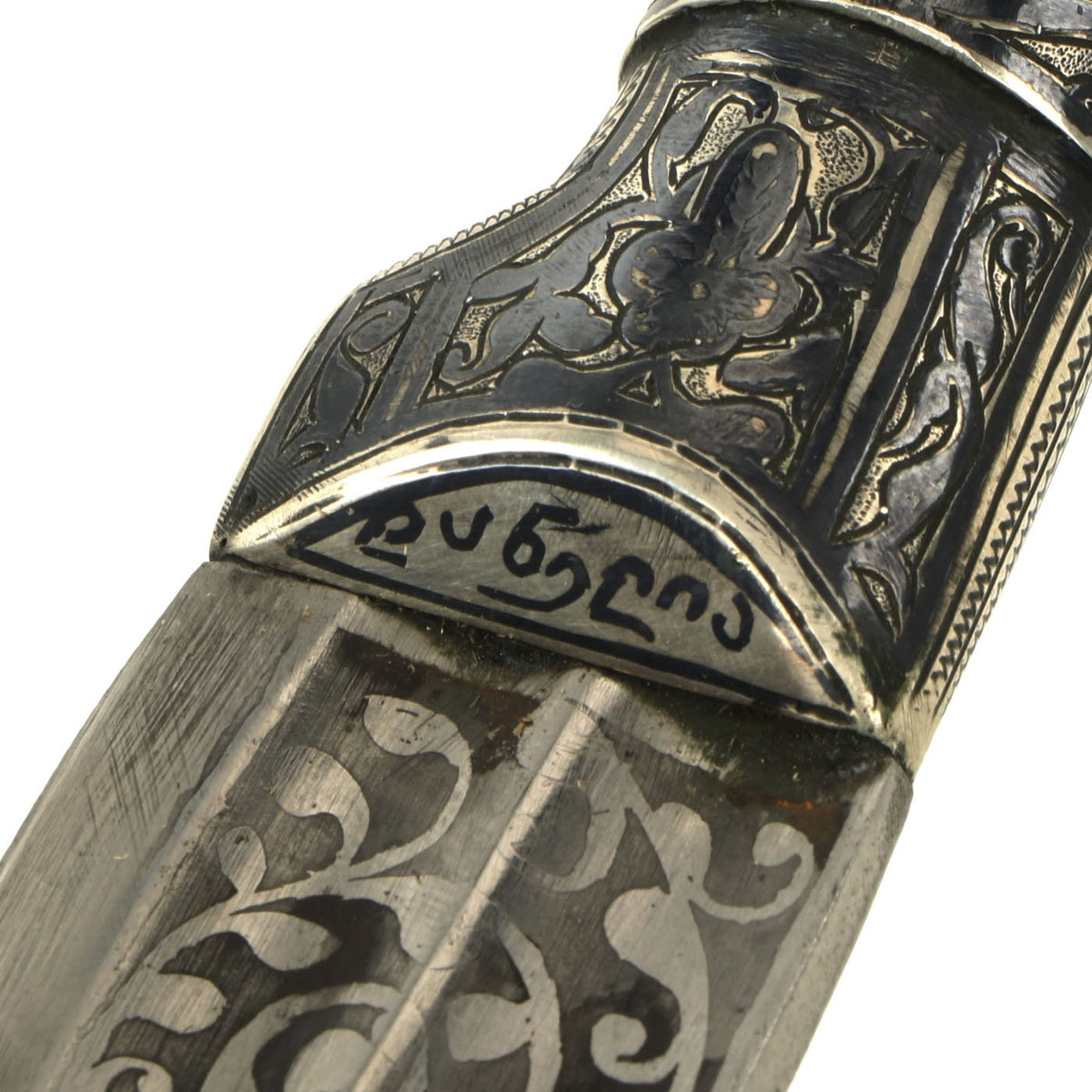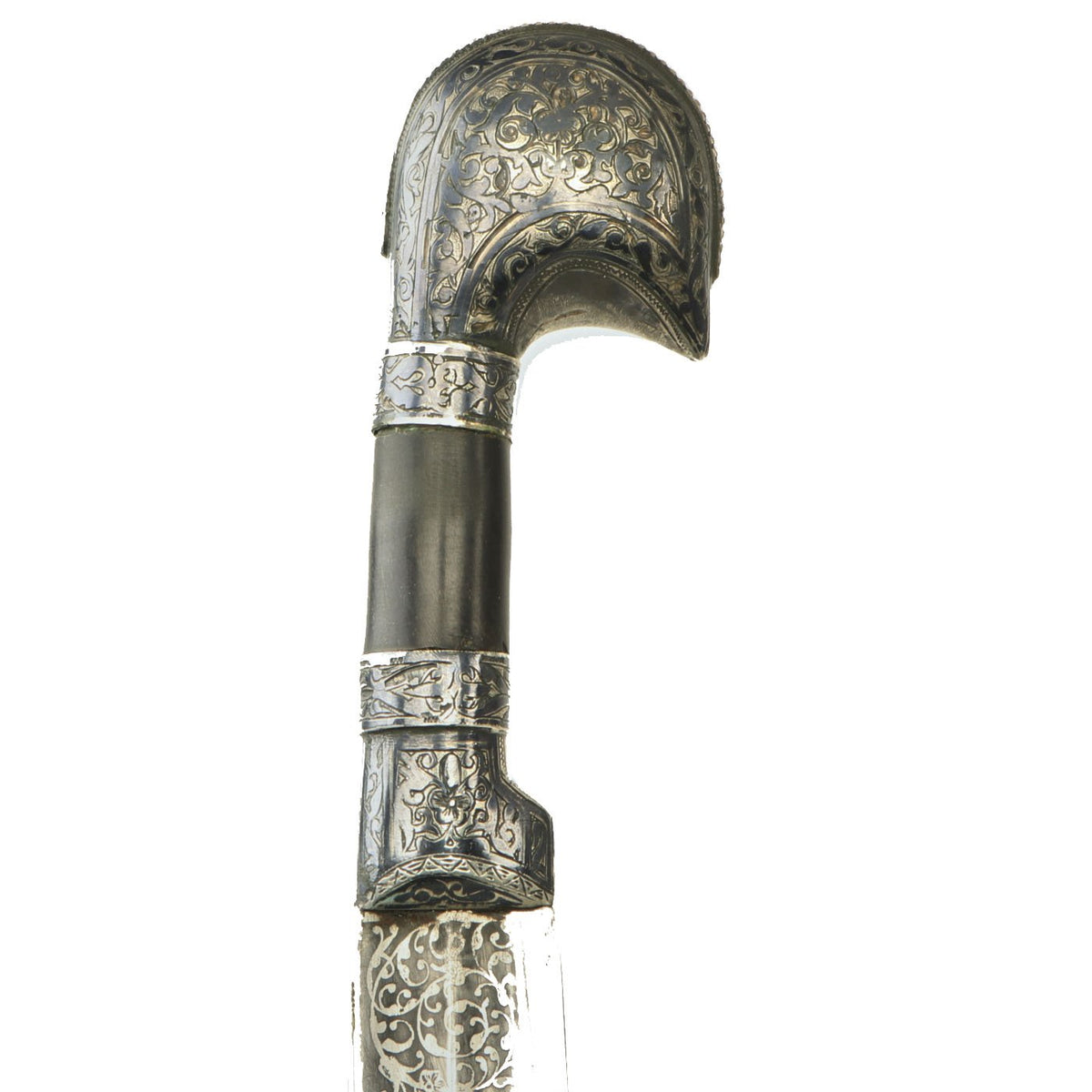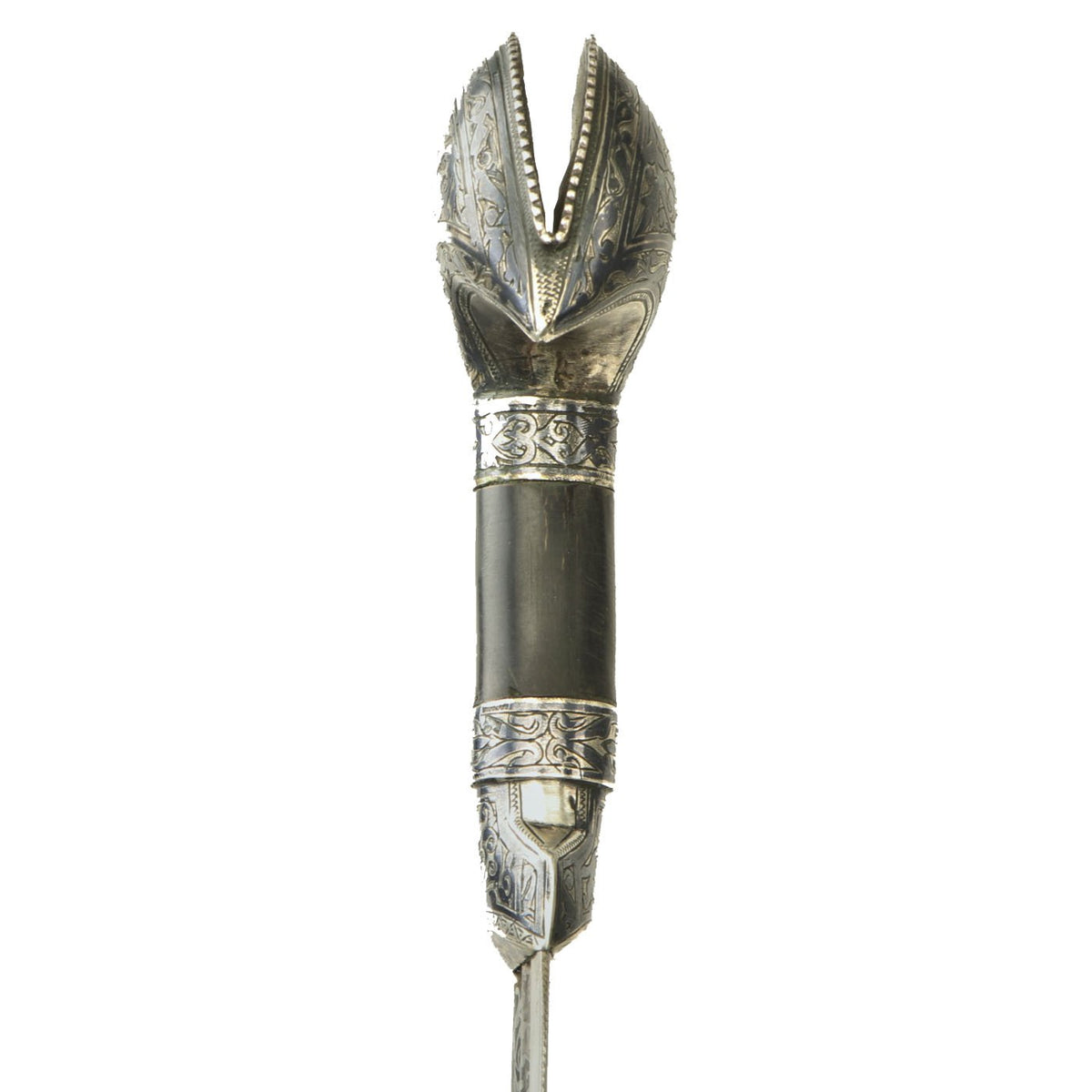Original Georgian Caucasian Shashka with Persian Style Blade & Ornate Niello Decorated Fittings circa 1870 Original Items
$ 5.495,00 $ 1.373,75
Original Item: One of a Kind. This is just lovely and comes from the Collection of a Russian immigrant to the U.S. This truly lovely SILVER mounted sword is all decorated in Niello work of carved silver, with blued intricate finish on both the totally silver covered hilt or grip and on the extensive silver mounts on the scabbard.
The hilt is SIGNED in Georgian script which translates to “SIMON DANELLA”, a well documented Sword Maker of the Victorian era circa 1860-1880. This signature is located on the sloped bolster where the hilt meets the blade on the right hand side of the sword.
In total length it measures 37″ with a 31 1/2″ curved blade, which has two large fullers running its entire length, typical of the style. The blade looks to be made of Persian-style “Wootz” steel, a form of laminated crucible steel, and the fullers are heavily etched with floral designs on both sides on the lower half of the blade.
The scabbard in leather covered wood in a rich plumb color with FOUR Niello Silver mounts, the second from top retaining its original leather belt loop, the third from top retaining it’s original suspension ring. Together with the substantial top and bottom mounts all decorated to match with the most intricate Niello Silver scroll engravings.
The Sword and scabbard are in most delightful condition and present wonderfully. Dating to the Victorian age maybe earlier this is ready to research and display!
Specifications:
Blade Length: 31 1/2″
Blade Style: Shashka
Overall length: 37“
Scabbard Length: 35″
The Shashka (Adyghe: сэшхуэ /IPA: [saʃxʷa]/ – big knife, Russian: (шашка)) is a special kind of sabre; a very sharp, single-edged, single-handed, and guardless sword. In appearance, the shashka is midway between a full sabre and a straight sword. It has a slightly curved blade, and can be effective for both slashing and thrusting. The blade is either hollowed or fullered. There is no guard, but a large, curved pommel. The hilt is frequently highly decorated. Shashkas from the Caucausus, as opposed to Russian versions, are carried in a wooden scabbard that encloses part of the hilt. It is worn with the cutting edge to the rear, opposite to the sabre.
The shashka originated among the mountain tribes of the Caucasus in the 12th century.[citation needed] Later most of the Russian and Ukrainian Cossacks adopted the weapon. Two styles of shashka exist: the Caucasian/Circassian shashka and the Cossack shashka.
The typically Circassian (Adyghe) form of sabre was longer than the Cossack type, in fact the Russian word shashka originally came from the Adyghe word – Adyghe: сэшхуэ (Shash ko) – meaning “long knife”. It gradually replaced the sabre in all cavalry units except hussars during the 19th century. Russian troops, having encountered it during their conquest of the Caucasus (1817-1864), preferred it to their issue sabres. The Russian Caucasian Corps first adopted it in the 1830s. In 1881 shashka became official weapon in Russian troops and police.
At this time they were 3 types of shashkas.
1. Caucasus type where the handle almost sits inside the scabbard, this type was used by Kuban Cossack and tribes from Caucasus. Only one problem was with this type of shashka that during rain water could go down into the scabbard, but this type of shashka was very light 300-400 grams, very flexible, strong and sharp. The best and most famous shashkas of this types were Gurda (strong and sharp like bulat), Volchek (running wolf symbol on the blade).
2. The Don Cossack shashka has straighter blade which gave Cossacks something in the middle to combine two things in one like cutting from the horse and also fence. The weight of this shashka is around 1 kilogram.
3. Terek Cossack shashka, the handle like the Don Cossack shashka does not go inside the scabbard. It is very light and strong.
The absence of the guard is inherited from the original Caucasian construction, in which the shashka is nearly completely hidden in the scabbard, together with the hilt. The hilt is slightly curved down, thus providing an additional leverage for pulling the shashka and for additional force by wrist action.
The handle of the sabre was crafted so as to have a built-in pommel and possibly a small guard, which usually extended to only one side of the hilt. Like most medieval and then imperial Russian weaponry of the time, often the shashka and its scabbard were very ornately decorated, with gold and silver engravings, embedded gems and stones placed into, and figures carved out of or into, the hilts. The blade of the sabre was generally double or triple-fullered, and due to its greater width than that of the European sabre and its unique styles of tempering, it was much stronger too[citation needed], able to deal damage to light body armor.
The shashka has the feel of a European sabre and was notable for its sharpness. There has been film footage of Tsar Nicholas II (1868-1918) using a Circassian sabre in an overhead twirling motion to horizontally cut pieces from a wooden pole
Fast Shipping with Professional Packaging
Thanks to our longstanding association with UPS FedEx DHL, and other major international carriers, we are able to provide a range of shipping options. Our warehouse staff is expertly trained and will wrap your products according to our exact and precise specifications. Prior to shipping, your goods will be thoroughly examined and securely secured. We ship to thousands clients each day across multiple countries. This shows how we're dedicated to be the largest retailer on the internet. Warehouses and distribution centres can be located throughout Europe as well as the USA.
Note: Orders with more than one item will be assigned a processing date depending on the item.
Before shipping before shipping, we'll conduct a thorough inspection of the items you have ordered. Today, the majority of orders will be delivered within 48 hours. The delivery time will be between 3-7 days.
Returns
The stock is dynamic and we cannot completely manage it because multiple stakeholders are involved, including our factory and warehouse. So the actual stock may alter at any time. It's possible that you may not receive your order once the order has been made.
Our policy is valid for a period of 30 days. If you don't receive the product within 30 days, we are not able to issue a refund or an exchange.
You can only return an item if it is unused and in the same state as the day you received it. You must have the item in its original packaging.
Related products
Uncategorized
Uncategorized
Uncategorized
Uncategorized
Uncategorized
Uncategorized
Angolan Rebel 1970s era 60mm Inert Display Mortar from Angolan Civil War Original Items
Uncategorized
Australian WWII Owen MK1 Machine Carbine SMG Custom Fabricated Replica with Sling Original Items
Uncategorized
Uncategorized
Uncategorized
Uncategorized
Uncategorized
Uncategorized
Uncategorized
Uncategorized
Uncategorized
Uncategorized

